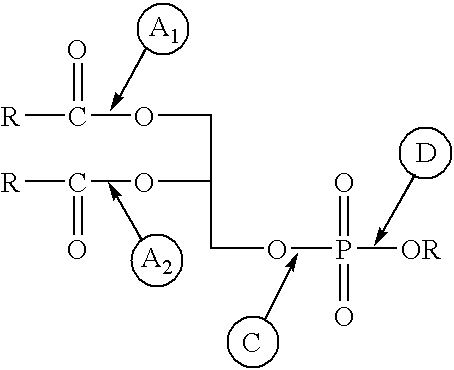Enzymatic transesterification or hydrolysis of phospholipids in aqueous media
a technology of phospholipids and aqueous media, which is applied in the direction of enzymology, biochemistry apparatus and processes, on/in inorganic carriers, etc., can solve the problems of poor enzymatic activity and difficult use of detergents or organic solvents, and achieves reduced pg formation rate, high rate, and high viscosity of incubation medium.
- Summary
- Abstract
- Description
- Claims
- Application Information
AI Technical Summary
Benefits of technology
Problems solved by technology
Method used
Image
Examples
example 1
Isolation of Phospholipase D from Cabbage
[0082]A. Standard Preparation
[0083]Phospholipase D was prepared from Savoy cabbage according to the procedure of Yang. A crude extract was first prepared by homogenizing 4250 kg of light-green leaves of fresh Savoy cabbage with distilled water in a Waring blender. The fibrous material was removed by filtering through a gauze. The final volume of the cabbage juice (3750 liters) was then centrifuged at 500 g for 5 minutes at 4° C. The extract was heated to 55° C., maintained at this temperature for 5 minutes, and then rapidly cooled. The bulky precipitate was removed by centrifugation under the same conditions and discarded.
[0084]Two volumes of acetone were added to the supernatant at −15° C., and the mixture was shaken immediately and stored overnight at 4° C. The acetone was evaporated and the aqueous suspension was centrifuged. The supernatant was discarded and the precipitate lyophilized overnight under 150 millitorr vacuum. The enzyme, obt...
example 2
Determination of Conversion
[0088]Lipids are extracted from the incubation mixture by vortexing with a 1:1:1 mixture of chloroform:methanol:water and allowing the phases to separate. The upper aqueous-methanolic phase contains all the water soluble reagents, while the lower chloroformic phase contains the lipids (e.g. PC, PG and phosphatidic acid (PA)). Aliquots of the lower phase are loaded on Analtech silicic acid thin layer on a glass plate for TLC. The phospholipids are separated (FIG. 1) using a solvent system of chloroform:acetone:mezhanol:acetic acid:water (6:8:2:2:1 v / v). The individual spots are scraped into phosphorous free test tubes, and the phosphorous content is determined using the perchloric acid based Bartlet procedure (see e.g. Barenholz et al., 1993).
[0089]An alternative assay for assessing conversion, based on the use of a radioactive water soluble reagent, was developed during the course of this work. For example, tritiated glycerol or serine is used; i.e. 3H-gly...
example 3
Conversion of PC to PG using Activated or Deactivated Adsorbent
[0092]Egg PC (10 mg) was dispersed in 0.5 ml of 50 mM acetate buffer (pH 5.6) containing 50 mM CaCl2 and 50% (vol) glycerol. Cabbage phospholipase D (Boehringer) was added (0.5 mg), and the reaction was started by adding 200 mg of silicic acid or Mg-silicate as normal powder, activated or deactivated. The reaction mixtures were shaken at room temperature for 30 minutes. The reactions were terminated by adding 0.5 ml of distilled water and 2 ml of a CHCl3:methanol mixture (1:1). The lipids were extracted from the lower phase after centrifugation.
PUM
| Property | Measurement | Unit |
|---|---|---|
| mean particle size | aaaaa | aaaaa |
| mean particle size | aaaaa | aaaaa |
| concentration | aaaaa | aaaaa |
Abstract
Description
Claims
Application Information
 Login to View More
Login to View More - R&D
- Intellectual Property
- Life Sciences
- Materials
- Tech Scout
- Unparalleled Data Quality
- Higher Quality Content
- 60% Fewer Hallucinations
Browse by: Latest US Patents, China's latest patents, Technical Efficacy Thesaurus, Application Domain, Technology Topic, Popular Technical Reports.
© 2025 PatSnap. All rights reserved.Legal|Privacy policy|Modern Slavery Act Transparency Statement|Sitemap|About US| Contact US: help@patsnap.com

